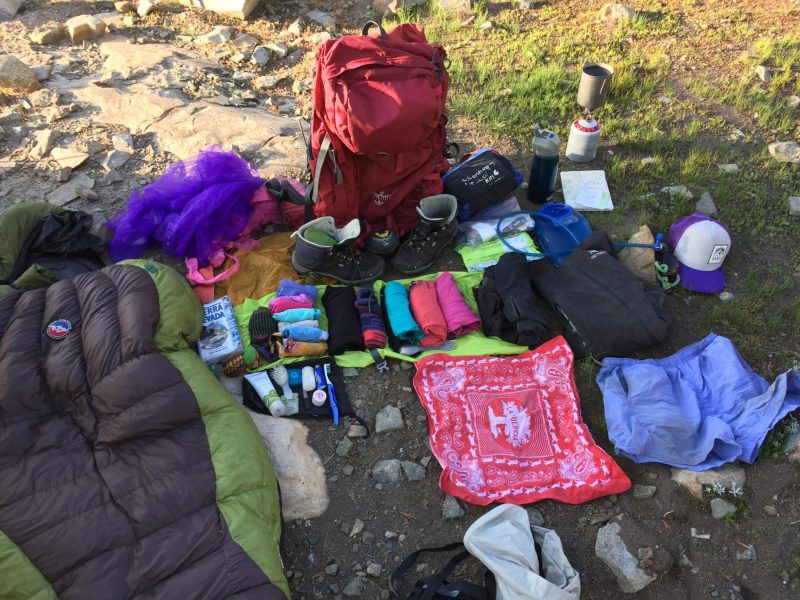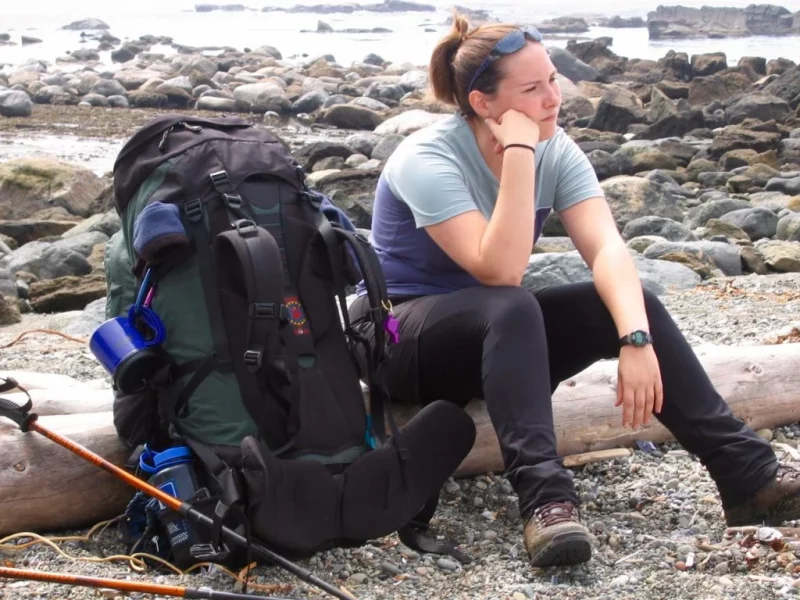What to wear backpacking? This is the question you might think of when you plan on going trekking, traveling, or hiking for the first time. When embarking on a backpacking adventure, proper clothing choices are crucial for the comfort, safety, and overall enjoyment of your trip.
The right clothing can protect you from the elements, regulate your body temperature, and provide versatility for various activities and climates. In this complete guide, we will walk you through everything you need to know about dressing for backpacking, ensuring you’re prepared for any adventure that comes your way.

Layering is Key
When you search for what to wear backpacking, you will find most guides telling you that layering is the foundation of dressing for backpacking. By layering your clothing, you can easily adjust to changing weather conditions and regulate your body temperature. The three main layers are:
- Base Layer: Start with a moisture-wicking base layer that sits directly against your skin. Choose lightweight and quick-drying materials such as merino wool or synthetic fabrics. These base layers will help regulate your body temperature, wick away sweat, and keep you dry and comfortable.
- Insulating Layer: The insulating layer provides warmth and insulation. It can be a lightweight fleece jacket, a down or synthetic insulated jacket, or a combination of both. This layer traps heat close to your body and provides warmth in colder temperatures.
- Outer Layer: The outer layer, often a waterproof and windproof jacket, protects you from the elements. Look for a jacket that is breathable yet offers adequate protection from rain, wind, and snow. Choose a lightweight and packable option that can be easily stowed in your backpack.

Choose the Right Fabrics
Opt for fabrics that are lightweight, breathable, quick-drying, and moisture-wicking. Fabrics like merino wool, synthetic blends, and technical fabrics are ideal for backpacking. These materials keep you comfortable by wicking away moisture, drying quickly, and resisting odors. Avoid cotton as it retains moisture and takes longer to dry, leading to discomfort and potentially hypothermia in colder conditions. When searching for what to wear backpacking, make sure you make a list of these items to remember them.
Tops and Bottoms
Pack a mix of short-sleeve and long-sleeve shirts that can be easily layered. Choose versatile colors that can be mixed and matched. For bottoms, consider lightweight and quick-drying pants or convertible pants that can be zipped off into shorts. Opt for pants with multiple pockets to keep essentials within reach. Additionally, pack a pair of leggings or thermal pants for colder climates.

Footwear
Selecting the right footwear is vital for backpacking. Invest in a sturdy pair of hiking boots that provide ankle support and have a good grip on various terrains. Break them in before your trip to avoid discomfort or blisters. Additionally, bring a pair of lightweight and breathable sneakers for casual walks or city explorations.
Don’t forget to pack moisture-wicking socks made of merino wool or synthetic materials to keep your feet dry and comfortable. When searching for what to wear backpacking, make sure you pay special attention to footwear and remember it when you are packing your bags.
Consider the Climate
Before packing your backpacking wardrobe, consider the climate of your destination and the time of year. Research the average temperatures, precipitation levels, and weather patterns to ensure you pack accordingly. For colder regions, include warmer layers such as a thermal base layer, a heavier insulating jacket, and waterproof pants. In warmer climates, focus on lightweight and breathable clothing, including moisture-wicking shirts and shorts.

Accessories and Essentials
Don’t overlook the importance of accessories and essential items for your backpacking wardrobe. When you search for what to wear backpacking, make sure you pay special attention to these essentials and accessories. Consider the following:
- Headwear: Bring a wide-brimmed hat or a cap to protect yourself from the sun. In colder climates, pack a beanie or a hat that covers your ears.
- Sunglasses: Protect your eyes from harmful UV rays and glare by packing a reliable pair of sunglasses.
- Gloves: In colder regions, thermal gloves are essential to keep your hands warm and protected.
- Buff or Bandana: A versatile accessory that can be used as a scarf, headband, or face cover for sun protection, warmth, or dust.
- Backpack Rain Cover: Ensure your backpack stays dry during rainy conditions by using a waterproof rain cover.
- Travel Towel: Pack a lightweight and quick-drying travel towel for bathing, swimming, or as an emergency towel.
- First Aid Kit: Include a compact first aid kit with essential items such as band-aids, antiseptic wipes, pain relievers, and any necessary prescription medications.
- Insect Repellent: Protect yourself from insects and ticks by packing a reliable insect repellent.
- Headlamp or Flashlight: A hands-free lighting solution is crucial for navigating in low-light conditions or during nighttime activities.
- Multi-tool or Swiss Army Knife: These versatile tools come in handy for various tasks such as cooking, repairing gear, or opening cans.
- Water Bottle or Hydration System: Stay hydrated on the trail by carrying a durable and reusable water bottle or investing in a hydration system with a reservoir and drinking tube.
- Navigation Tools: Depending on your level of expertise, carry a map, compass, or GPS device to ensure you stay on the right path and find your way back if needed.
- Extra Batteries and Power Bank: Keep your electronic devices, such as GPS or headlamps, powered up by bringing extra batteries or a portable power bank.
- Ziplock Bags: These versatile bags are useful for organizing and protecting small items, storing snacks, or keeping electronics dry.
- Duct Tape: A small roll of duct tape can be a lifesaver in emergency gear repairs or makeshift solutions on the trail.
- Trekking Poles: Depending on the terrain and personal preference, trekking poles can provide stability, reduce strain on your joints, and enhance your hiking experience.
When packing your bags as per your search for what to wear backpacking, remember to prioritize lightweight and functional items that serve multiple purposes. Take into account the duration and nature of your backpacking trip to determine the specific accessories and essential items you need to pack.

By considering these accessories and essential items, you’ll be well-prepared for any situation or emergency that may arise during your backpacking adventure. Don’t underestimate the value of these small but significant items in enhancing your comfort, safety, and overall enjoyment of the trip.
Pack Light and Smart
When preparing for a backpacking trip, keep in mind that you’ll be responsible for carrying everything on your back. That’s why it’s essential to pack in a light and intelligent manner. Opt for versatile clothing options that can be easily mixed and matched, allowing you to create multiple outfits with fewer items.
Prioritize lightweight and quick-drying fabrics to minimize the weight of your backpack and ensure you stay comfortable during your journey. Additionally, consider using packing organizers such as compression sacks or packing cubes to maximize the available space in your backpack and keep your gear neatly organized. By packing light and utilizing smart packing techniques, you’ll have a more enjoyable and manageable backpacking experience.
Read more: How to Adjust Backpack Straps in Simplest Way
Test and Plan Ahead
Before embarking on your backpacking trip, it is highly recommended to test your clothing and gear thoroughly. Plan a day hike or a short overnight trip to evaluate the comfort, fit, and functionality of your clothing. This testing phase allows you to identify any issues or areas that require adjustments or replacements, ensuring a smoother and more enjoyable experience during your actual backpacking adventure.
By taking the time to test your clothing and gear beforehand, you can address any concerns and make necessary modifications, guaranteeing that you are well-prepared for the challenges that lie ahead. Remember to keep the information you gathered when searching for what to wear backpacking when you are planning ahead.

Care and Maintenance
Proper care and maintenance of your clothing are crucial for ensuring its longevity and optimal performance. Take the time to carefully read and follow the care instructions provided by the manufacturer for each garment.
When you’re out on the trail, it’s important to practice Leave No Trace principles, which include avoiding excessive dirt or stains that can compromise the functionality of your clothing. By taking good care of your backpacking wardrobe, you’ll be able to enjoy its benefits for many adventures to come.
In conclusion, dressing appropriately for backpacking is essential for a successful and enjoyable trip. By layering your clothing, choosing the right fabrics, considering the climate, and packing essential accessories, you’ll be prepared for various weather conditions and outdoor activities.
Remember to pack light, test your gear, and plan ahead to make the most of your backpacking experience. Do your research, search for reliable sources for what to wear backpacking, and get in touch with people who are pros at trekking, hiking, or traveling. They will be your real-world guide. Now, get ready to hit the trails with confidence and embark on your next incredible adventure!

